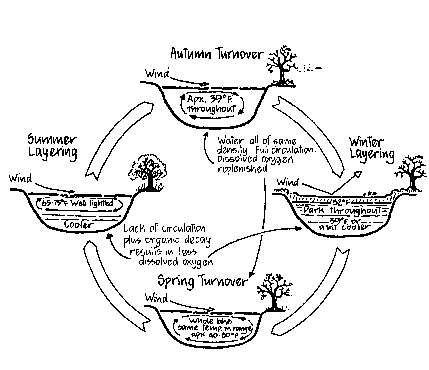|
 |
|
The most important actions causing lake mixing are wind, inflowing water, and outfiowing water. While wind influences the surface waters of all lakes, its ability to mix the entire water volume in summer-stratified lakes is greatly reduced. This is because the rapid change in temperature and density within the metalimnion acts like a physical barrier between the epilimnion and hypolimnion. Though not an absolute barrier, it takes a lot of energy to disrupt it.
The stability of a lake’s stratification depends on many factors, most
importantly the lake’s depth, shape, and size. Also playing a role are
climate, orientation of the lake to the wind, and inflow! outflow. As
noted earlier, in shallow lakes (less than about 10 to 12 feet deep)
wind forces are usually strong enough to mix the water from top to
bottom and thereby thwart summer stratification. Lakes with a lot of
water flowing through them (i.e., a short water residence time) also do
not develop persistent thermal stratification. While a temperature
gradient from warmer surface to cooler bottom waters may exist in such
lakes, a true metalimnion is not typically formed.
Summer stratification continues until fall when surface waters begin to
cool and sink. The metalimnion begins to ‘erode” and weaken, and
continues to do so as the lake cools. Wind energy helps mix the lake
deeper and deeper. When the whole lake reaches a similar temperature,
wind forces are again able to mix the lake from top to bottom in a
process called fall turnover. The
transition from summer stratification to fall tumover can occur within
just a few hours, especially if accompanied by strong winds.
Effects of Stratification
Stratification has important implications for fisheries
management, phytoplankton (algae) populations, and water supply quality.
A discussion of a few stratification impacts follows.
Dissolved Oxygen
Just after summer stratification is established, the
hypolimnion is rich in dissolved oxygen from the early spring mixing of
the lake. However, because the metalimnion acts as a barrier between the
epilimnion and hypolimnion, the hypolimnion is essentially cut off from
oxygen exchange with the atmosphere and is often too dark for plants and
algae to grow and produce oxygen by photosynthesis. In a eutrophic
(nutrient-rich) lake, the hypolimnion can become anoxic
(without oxygen, or anaerobic) as the summer
progresses. This occurs as its supply of oxygen is consumed by bacteria
and other bottom- dwelling organisms. A lack of dissolved oxygen can
have serious consequences.
Phosphorus and Nitrogen: In
anoxic conditions, the nutrients phosphorus and ammonia-nitrogen become
more soluble (dissolvable) and are released from the bottom sediments
into the hypolimnion. During the summer, stratified lakes can sometimes
|
|